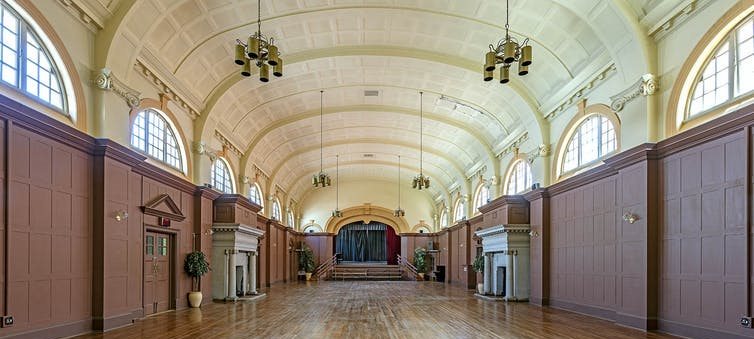
The skylight of the Weskoppies Chapel in Pretoria.Alain Proust/Hidden Pretoria
Pretoria’s inner-city buildings tell a history of the city’s politically central role. Its 19th century development as the capital of the Zuid Afrikaansche Republiek can be understood through edifices such as the Old Government Building on Church Square, with its beautiful yet underutilised interiors still in excellent condition.
The Union Buildings place it within the British Empire as capital city of the Union of South Africa, but this Edwardian development has also been adopted as the administrative heart of post-apartheid South Africa since 1994. Large scale projects such as the Transvaal Provincial Administration building, now abandoned, date back to apartheid-era South Africa.
Other historical sites featured in Hidden Pretoria are to be found along the periphery of the city and they tell lesser known stories. Examples include the fortifications along Pretoria’s ridges dating from the South African War (1899-1902) and the Westfort Leprosy Hospital, now informally occupied by a transient residential community.
One of the most interesting and complex sites is the Weskoppies Psychiatric Hospital, a few kilometres west of the Pretoria Railway Station.

View towards the main buildings at Weskoppies, the Transvaal Colony’s interpretation of British asylum models. Alain Proust/Hidden Pretoria, CC BY
Weskoppies: an architectural history
Weskoppies has been an important node in the country’s mental health landscape since the late 1800s. Originally known as the Krankzinnigen Gesticht or Pretoria Lunatic Asylum, it was the first institution of its kind in the region.
It still serves today in its original capacity as the main state-run psychiatric hospital in the region. The extensive property faces severe conservation challenges and it has lost some of its original character in recent decades. But the early 20th century main buildings are impressive and good examples of the era.
Weskoppies was opened as a dedicated facility for psychiatric patients in 1892. Before that members of society deemed “insane” would have been consigned to jails. The construction of Weskoppies to modern standards for humane conditions can be seen as an enlightened step. Of course, the consideration was mainly for the public good. Patients were committed to the facility under the force of legislation.
By the end of the 1800s, Weskoppies was already overcrowded. Significant additions were made by the Transvaal Colony after the South African War. During this time, other medical and scientific facilities were built too, such as Pretoria’s Onderstepoort Veterinary Research Institute.

The kitchen complex seen within the Weskoppies landscape on the northern slope of a Pretoria ridge line. Alain Proust/Hidden Pretoria, CC BY
The Weskoppies main buildings of 1907 were designed by the Transvaal Public Works Department under the supervision of Piercy Eagle. These comprise an extended chain of Edwardian structures along a ridge, connected by courtyards and long passages that allow for ventilation and natural light in patient areas.
Architectural highlights are the hall and chapel, two beautiful spaces incorporated into the main complex. Originally, Weskoppies was developed as a healing landscape with well-tended gardens and cultivated fields. The landscape still plays a role, but there has been some degradation of the gardens. The more recent building developments have not added to the quality of the site.
Psychiatric facilities often operate outside public attention. Although the sensitivity of their programmes requires a degree of privacy, institutional seclusion is no longer a necessity. Treatment has shifted from isolation to curative practices, and recent academic engagement with the University of Pretoria Medical School also connects the hospital to ongoing clinical research.

The unique Edwardian era gathering hall at the Weskoppies Psychiatric Hospital. Alain Proust/Hidden Pretoria., CC BY
Today, the original main buildings are only partially occupied but they could carry on functioning as the heart of the campus if they were maintained with care.
Weskoppies is a historically significant site and is formally designated as a provincial heritage resource. So the maintenance and restoration of the grand old hospital should be a priority for government stakeholders.
This article is an adaptation of text published in Hidden Pretoria. You can order a copy of the book over here.
This article is republished from The Conversation under a Creative Commons license. Read the original article.


































